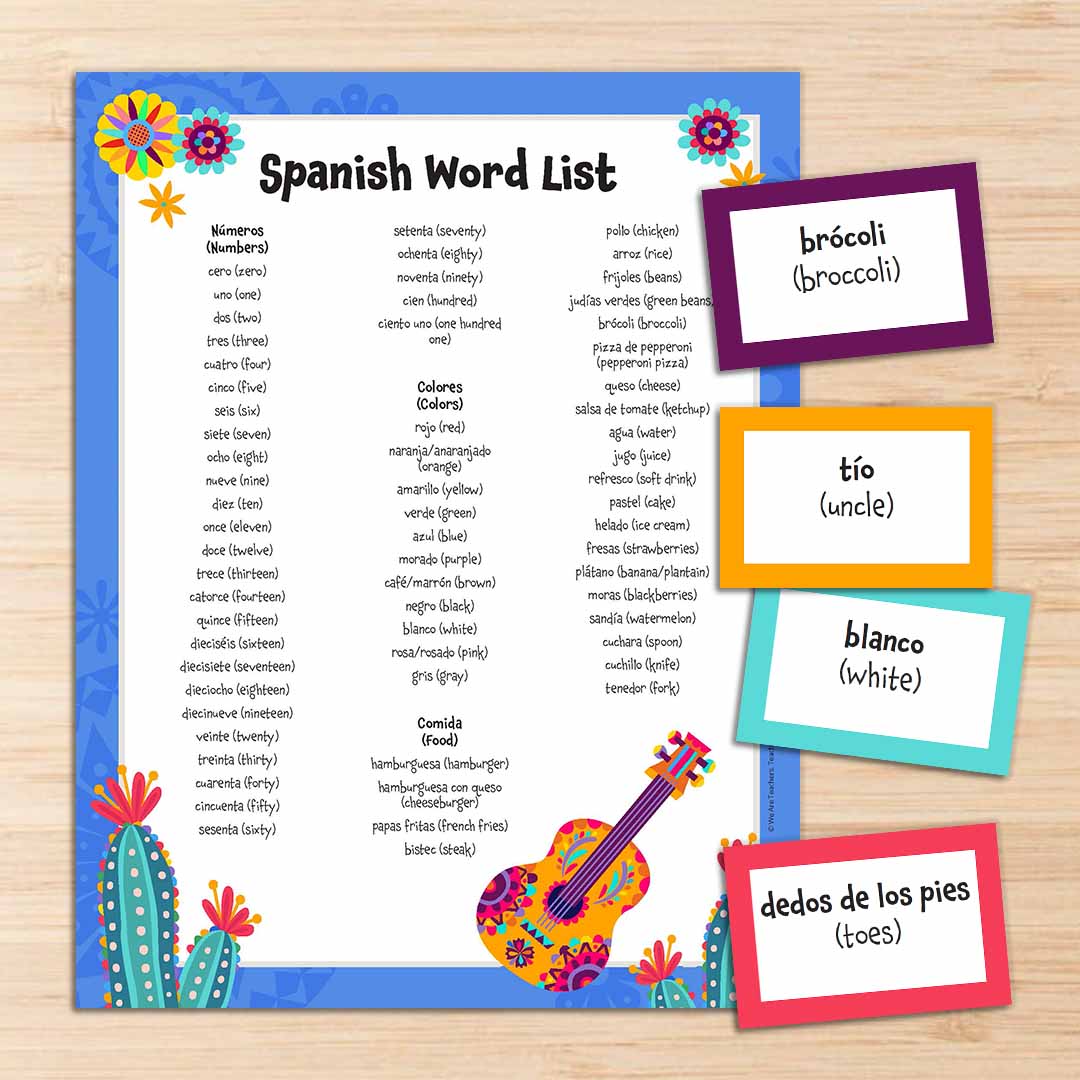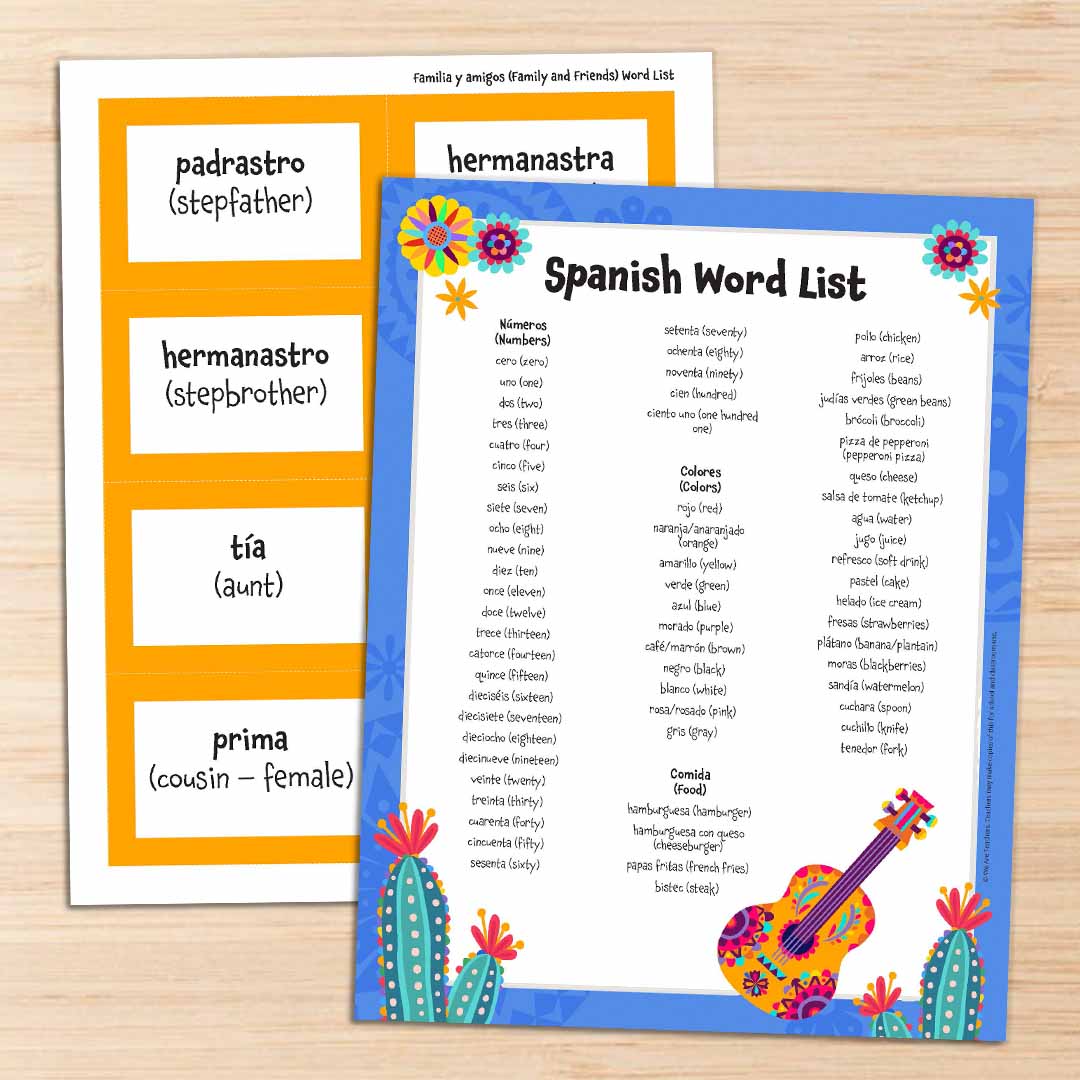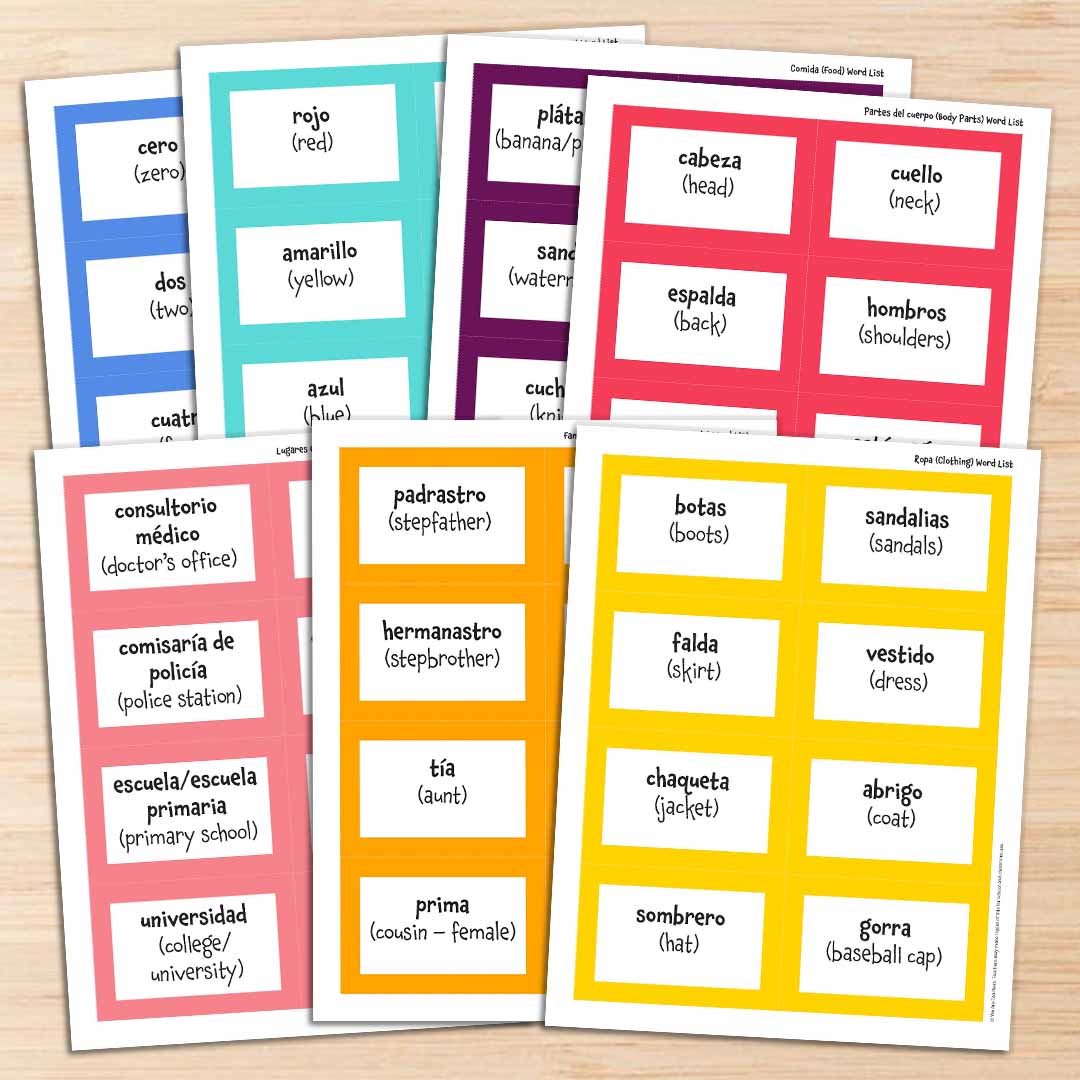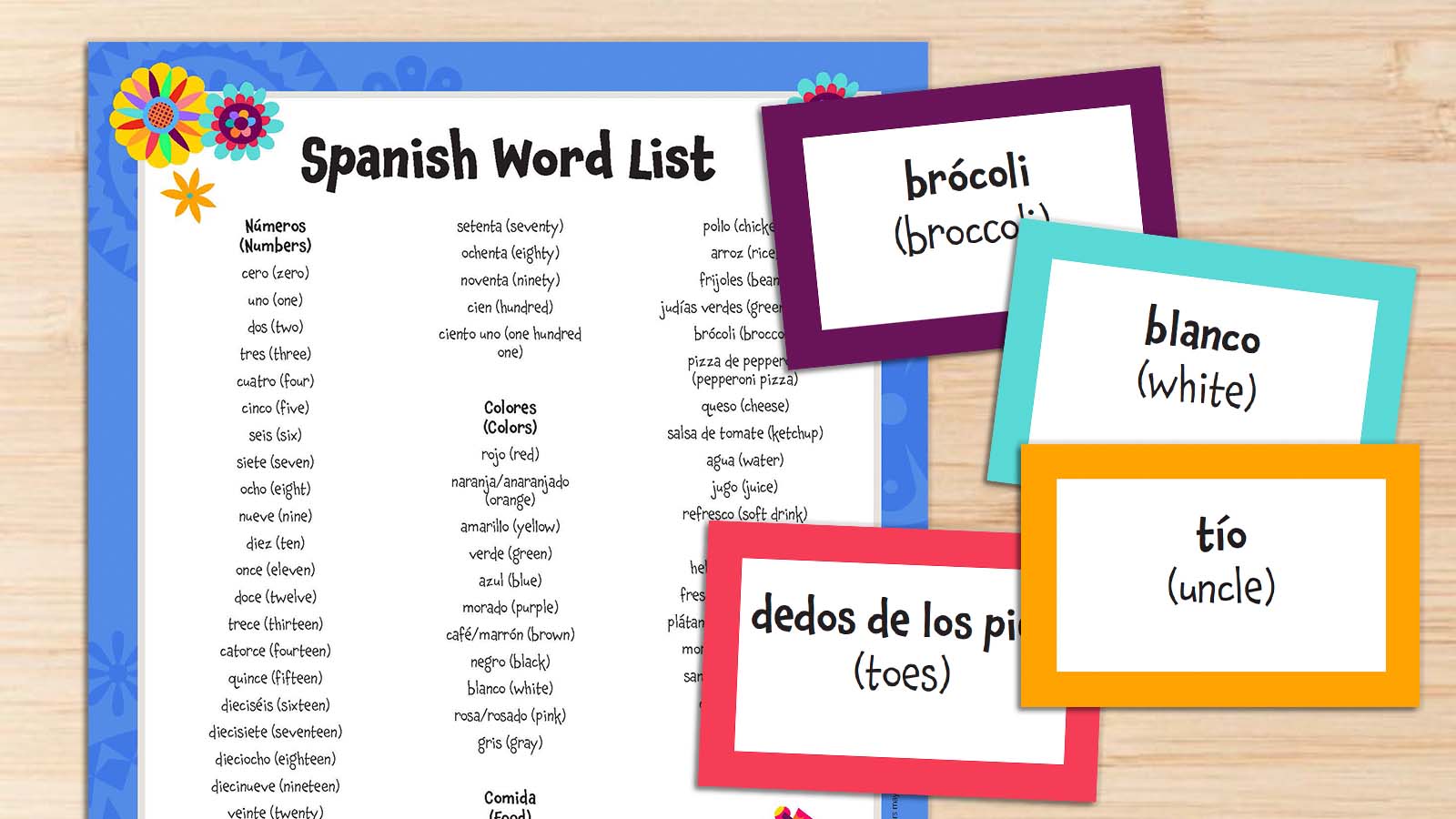Spanish is a great language to integrate into your classroom. It’s the second-most spoken language in the United States, with nearly 42 million people reporting they speak Spanish in their home. Those who enter the workforce bilingual have a significant advantage in almost every career field. When immersion isn’t possible (We can’t all move to another country!), the next best way to learn language is through association—attaching the meaning of the Spanish word to a word in English. This allows the brain to cognitively map the words. The Spanish vocabulary words and activities below will help your students have fun while beginning their language-learning journey.
Plus, grab our free printable Spanish vocabulary lists and cards. Just fill out the form on this page for instant access.
Benefits of Learning Spanish
Learning Spanish as a second language has benefits that reach far beyond the actual words that are acquired. In fact, research dispels the myth that it confuses children. To the contrary, learning more than one language has benefits across the lifespan from the youngest infants to those far along their life journey. As the brain learns a second language, it also improves executive function—including the ability to tackle complex tasks, solve problems, and plan and carry out a series of tasks.
Spanish Vocabulary Words

Números (Numbers)
cero (zero)
uno (one)
dos (two)
tres (three)
cuatro (four)
cinco (five)
seis (six)
siete (seven)
ocho (eight)
nueve (nine)
diez (ten)
once (eleven)
doce (twelve)
trece (thirteen)
catorce (fourteen)
quince (fifteen)
dieciséis (sixteen)
diecisiete (seventeen)
dieciocho (eighteen)
diecinueve (nineteen)
veinte (twenty)
treinta (thirty)
cuarenta (forty)
cincuenta (fifty)
sesenta (sixty)
setenta (seventy)
ochenta (eighty)
noventa (ninety)
cien (hundred)
ciento uno (one hundred one)
Colores (Colors)
rojo (red)
naranja/anaranjado (orange)
amarillo (yellow)
verde (green)
azul (blue)
morado (purple)
café/marrón (brown)
negro (black)
blanco (white)
rosa/rosado (pink)
gris (gray)
Comida (Food)
hamburguesa (hamburger)
hamburguesa con queso (cheeseburger)
papas fritas (french fries)
bistec (steak)
pollo (chicken)
arroz (rice)
frijoles (beans)
judías verdes (green beans)
brócoli (broccoli)
pizza de pepperoni (pepperoni pizza)
queso (cheese)
salsa de tomate (ketchup)
agua (water)
jugo (juice)
refresco (soft drink)
pastel (cake)
helado (ice cream)
fresas (strawberries)
plátano (banana/plantain)
moras (blackberries)
sandía (watermelon)
cuchara (spoon)
cuchillo (knife)
tenedor (fork)
plato (plate)
servilleta (napkin)
desayuno (breakfast)
almuerzo (lunch)
cena (dinner)
postre (dessert)
Partes del cuerpo (Body Parts)
cabeza (head)
cuello (neck)
espalda (back)
hombros (shoulders)
pecho (chest)
estómago (stomach)
caderas (hips)
brazos (arms)
codos (elbows)
manos (hands)
rodillas (knees)
pies (feet)
dedos de los pies (toes)
Lugares en la ciudad (Places in the City)
casa (house)
jardín (garden)
calle (street)
edificio (building)
farmacia (pharmacy)
supermercado (supermarket)
restaurante (restaurant)
hospital (hospital)
consultorio médico (doctor’s office)
mercado (market)
comisaría de policía (police station)
departamento de bomberos (fire department)
escuela/escuela primaria (primary school)
colegio (secondary school)
universidad (college/university)
taller mecánico (mechanic shop)
tienda de ropa (clothing shop)
peluquería (hair salon)
oficina de correos (post office)
ferretería (hardware store)
iglesia (church)
Familia y amigos (Family and Friends)

familia (family)
madre (mother)
mamá (mom)
padre (father)
papá (dad)
hermano (brother)
hermana (sister)
madrastra (stepmother)
padrastro (stepfather)
hermanastra (stepsister)
hermanastro (stepbrother)
tío (uncle)
tía (aunt)
primo (cousin – male)
prima (cousin – female)
abuela (grandmother)
abuelo (grandfather)
nieto (grandson)
nieta (granddaughter)
sobrino (nephew)
sobrina (niece)
amigo (friend – male)
amiga (friend – female)
vecino (neighbor – male)
vecina (neighbor – female)
Ropa (Clothing)
camiseta (T-shirt)
camisa (shirt)
suéter (sweater)
pantalones (pants)
pantalones cortos (shorts)
bermudas (knee-length shorts)
medias/calcetines (socks)
zapatos (shoes)
botas (boots)
sandalias (sandals)
falda (skirt)
vestido (dress)
chaqueta (jacket)
abrigo (coat)
sombrero (hat)
gorra (baseball cap)
gorro (winter hat)
traje de baño (bathing suit)
Activities To Teach Spanish Vocabulary
Number Dash
Learning the numbers 1 through 20 is a great start to learning Spanish. One way to learn the numbers is through a number dash. To set up this activity, first print as many sets of the number words in Spanish you will need for your number of teams. Next, make two lines fairly far apart with painter’s tape on your classroom floor or in the hallway (or using chalk outside). Place each set of numbers spread out on the far line. Students must be able to see each number in their pile and they should be in random order. Each team sends a student to run to collect the number in order. The first team to finish the race is the winner. If the students get the wrong order, they must go back!
Find the Object Color Activity
Next on your Spanish learning adventure is colors. After teaching the colors, students can practice through this Find the Color activity. Each team of students is given a flash card with a color written in Spanish. The team then has one minute to write down as many items as they can find with that color on it. They receive 1 point for each item in English and an extra point if they write the name of the object in Spanish. By the end of the minute, they turn in the paper and are given a new color. Repeat this cycle as many times as you would like. The team with the most points wins!
“Make a Menu” Food Activity
When learning words for food in Spanish, students can practice by creating a menu in Spanish. Students will use the list of food words to create a digital or paper menu. Next, students will go to each other’s restaurants and order. To do this task, divide the class in half. Half of the students sit at desks and half of the students are servers who bring a menu and write down the order. They have to repeat it back and make sure it is correct. Then the students switch roles.
Another fun take on this activity is to make menus for food trucks. Half the class rotates around and “visits” the people who are taking orders from a one-page menu. Then the students switch roles.
Parts of Your Body Sequence Activity
For this activity, after practicing the words for parts of the body, students line up across the front of the classroom where they can’t see each other. The teacher starts out as the caller. The caller gives a chain of body parts to touch in a row. For example, “Toca tu cabeza, toca tus pies” (“Touch your head, touch your feet”). When a student gets the chain in the wrong order or touches the wrong body part, they sit down. The chains can get longer and longer—requiring significant memory—until there is one student left standing. That student becomes the new “caller.”
Draw Places in the Community
For this activity, students will need personal whiteboards and a dry-erase marker. The teacher will pull a vocabulary word and ask a question in Spanish. The students then have to draw the place on their whiteboard. When the teacher says “revela” (reveal), the students show their drawings with the name labeled in Spanish. Incorrect drawings are a great opportunity to converse in Spanish.
For example, the teacher might draw the card “farmacia” (pharmacy). The teacher might come up with the question “Después del médico, ¿dónde voy a recoger mis medicamentos?” (“After the doctor, where do I go to pick up my medicine?”). Hearing the phrase, some beginning language students may draw the doctor’s office, the hospital, or the pharmacy. The teacher can then show the card and discuss the question and what the students thought they heard. With practice, they will improve their understanding.
Family Vocabulary (Alternative Activity That Doesn’t Involve Family Trees)
For students who are in foster care or adopted, or have two moms/two dads, stepparents, grandparents they live with, or other non-traditional family arrangements, drawing family trees can be stressful. Who do they include? Who do they leave out? Learning a language shouldn’t be emotionally stressful!
As an alternative, teachers can take the vocabulary cards and do this movement game.
First, the desks should be cleared from the center of the room. Next, the teacher places the family vocabulary cards taped around the room on the floor. The teacher then allows the students to walk around and learn the locations of all of the family-member word cards. When they are satisfied they know the location of each vocabulary card, they meet in the center of the room. (This activity is best done with just socks on if space is limited, in a gym, or outside.)
The teacher then calls out a relationship. For example, “El hermano de mi mamá es mi …” (“The brother of my mom is my …”). When students realize that the answer is “tío” (uncle), they run in the direction of the uncle and try to touch the card first with their hand (no diving for words!). The first student there gets the point and everyone else freezes where they are. The teacher calls the next word. The student might be right next to it or it might be far away, giving other students an advantage.
One thing to note for this activity is that students process at different speeds. The teacher should be aware of this and try to call enough words near slower processors to even the playing field and give all students a chance to win.
Paper Dolls
Students love to make paper dolls. It allows them to be creative. All you need for this activity is a pack of card stock, markers, and creativity! Additional items like googly eyes, yarn, sequins, pieces of scrap fabric, and buttons are fun but not necessary. After the students make a basic doll (think gingerbread man shape with only the face decorated), they can make clothing to go on top. If you have lots of time and creative students, they can use the entire list of clothing vocabulary cards to create interchangeable outfits. If you are doing this, it is important that they not glue the clothing on. You can ask questions such as “¿Qué te pondrías en la playa?” (“What would you wear to the beach?”) and have them change the outfit on the doll.
If you need an easier/faster option, have each student draw/color certain items directly on their paper doll. For example, one student might be assigned a beach outfit consisting of the vocabulary bathing suit, sun hat, and flip-flops. Another student’s vocabulary might be related to a winter outfit. Still another student’s an outfit for a rainy day. Then ask the questions and have them hold up their paper doll if it has that item on.
Have fun with it! You can always have them draw cards randomly for hats, shirts, pants, and shoes and come up with crazy outfits. You might end up with a paper doll with a ski hat, T-shirt, skirt, and ballet shoes! The more they laugh, the more chance they will retain the vocabulary.
Pocket Chart
The one activity that can be done with every vocabulary list for review is to use a pocket chart. Use vocabulary cards with a picture of the vocabulary word on one side and the Spanish word typed on the opposite side. Alternatively, use cards with English on one side and Spanish on the other (especially if it is a vocabulary word for which it is not easy to find a picture).
Call on a student (pick sticks if no one volunteers) and have them come to the front of the room and choose a card they are confident they know how to pronounce in Spanish. They point to the picture and state the word. If they are correct, the card is turned over and they can sit down. If they are incorrect, the teacher indicates that the answer is incorrect or they are close. They can try again with that word or choose another card. The activity is over when ALL of the cards are turned over to the Spanish side on the pocket chart.
Pro tip: Add the exact number of cards to the pocket chart as students present that day … even if that means reviewing previous vocabulary. Students quickly learn to volunteer as it is much easier to go at the beginning of the review game than at the end if everyone is expected to have one turn.
Language learning can be so much fun when you use vocabulary cards to create interactive activities. They engage every learner. Studies show students typically sit for too long and need more movement. So why not add some Spanish vocabulary activities to your classroom?
Get your free Spanish Vocabulary Printables now!

Just click the link below and you’ll get instant access to our word list.

